A Guided Vehicle under Fire Conditions Based on a Modified Ultrasonic Obstacle Avoidance Technology
Abstract
1. Introduction
2. Influencing Factors on Obstacle Distance Measurement
2.1. Relationship between Propagation Speed and Temperature
2.2. Relationship between Propagation Speed and Soot Concentration
3. Baffle Calibration Method
4. Validation by Experiments
4.1. Experimental Methodology
4.2. Distance Measurement
4.2.1. Fire Smoke with High Concentration and Low Temperature
4.2.2. Fire Smoke with a Low Concentration and High Temperature
4.3. Results and Discussion
5. Conclusions
Author Contributions
Funding
Acknowledgments
Conflicts of Interest
References
- Hurley, M.J.; Gottuk, D.T.; Hall, J.R.; Harada, K.; Kuligowski, E.D.; Puchovsky, M.; Torero, J.L.; Watts, J.M.; Wieczorek, C.J. SFPE Handbook of Fire Protection Engineering, 5th ed.; Springer: New York, NY, USA, 2016. [Google Scholar]
- Wu, C.H.; Chen, L.C. 3D spatial information for fire-fighting search and rescue route analysis within buildings. Fire Saf. J. 2012, 48, 21–29. [Google Scholar] [CrossRef]
- Shi, L.; Chew, M.Y.L.; Xie, Q.Y.; Zhang, R.F.; Li, L.M.; Xu, C.M. Experimental study on fire characteristics of PC monitors—Part II: Full-scale study under different ventilation conditions. J. Appl. Fire Sci. 2010, 19, 41–61. [Google Scholar] [CrossRef]
- Kim, J.H.; Starr, J.W.; Lattimer, B.Y. Firefighting robot stereo infrared vision and radar sensor fusion for imaging through smoke. Fire Technol. 2015, 51, 823–845. [Google Scholar] [CrossRef]
- Starr, J.W.; Lattimer, B.Y. A comparison of IR stereo vision and LIDAR for use in fire environments. In Proceedings of the 2012 IEEE Sensors, Taipei, Taiwan, 28–31 October 2012; pp. 1–4. [Google Scholar]
- Kiss, Á.; Szirányi, T. Reconstructing static scene viewed through smoke using video. In Proceedings of the 18th IEEE International Conference on Image Processing, Brussels, Belgium, 11–14 September 2011; pp. 3461–3464. [Google Scholar]
- Li, S. Study on Image Restoration and Human Detection in the Building during Fire Initial Stage. Ph.D. Thesis, University of Science and Technology of China, Hefei, China, 2014. [Google Scholar]
- Sales, J.; Marín, R.; Cervera, E.; Rodríguez, S.; Pérez, J. Multi-sensor person following in low-visibility scenarios. Sensors 2010, 10, 10953–10966. [Google Scholar] [CrossRef] [PubMed]
- Starr, J.W.; Lattimer, B.Y. Evaluation of navigation sensors in fire smoke environments. Fire Technol. 2014, 50, 1459–1481. [Google Scholar] [CrossRef]
- Willi, J.M.; Horn, G.P.; Madrzykowski, D. Characterizing a firefighter’s immediate thermal environment in live-fire training scenarios. Fire Technol. 2016, 52, 1667–1696. [Google Scholar] [CrossRef]
- Queirós, R.; Alegria, F.C.; Girão, P.S.; Serra, A.C. A multi-frequency method for ultrasonic ranging. Ultrasonics 2015, 63, 86–93. [Google Scholar] [CrossRef] [PubMed]
- Dai, H.; Zhao, S.; Jia, Z.; Chen, T. Low-Cost Ultrasonic Distance Sensor Arrays with Networked Error Correction. Sensors 2013, 13, 11818–11841. [Google Scholar] [CrossRef] [PubMed]
- Tsai, W.; Chen, H.; Liao, T. An ultrasonic air temperature measurement system with self-correction function for humidity. Meas. Sci. Technol. 2005, 16, 548–555. [Google Scholar] [CrossRef]
- Khyam, M.O.; Ge, S.S.; Li, X.; Pickering, M.R. Highly Accurate Time-of-Flight Measurement Technique Based on Phase-Correlation for Ultrasonic Ranging. IEEE Sens. J. 2017, 17, 434–443. [Google Scholar] [CrossRef]
- Merrell, T.; Saylor, J.R. Scavenging of micron-scale particles using a combination of fog and a cylindrical ultrasonic standing wave field. J. Aerosol Sci. 2017, 107, 14–30. [Google Scholar] [CrossRef]
- Luo, X.; Cao, J.; Yan, H.; He, L. Droplets banding characteristics of water-in-oil emulsion under ultrasonic standing waves. Ultrason. Sonochem. 2018, 41, 319–326. [Google Scholar] [CrossRef] [PubMed]
- Kulkarni, C.V. Ultrasonic processing of butter oil (ghee) into oil-in-water emulsions. J. Food Process. Preserv. 2017, 41, e13170. [Google Scholar] [CrossRef]
- Valierbrasier, T.; Conoir, J.M.; Coulouvrat, F.; Thomas, J.L. Sound propagation in dilute suspensions of spheres: Analytical comparison between coupled phase model and multiple scattering theory. J. Acoust. Soc. Am. 2015, 138, 2598–2612. [Google Scholar] [CrossRef] [PubMed]
- McClements, D.J. Comparison of multiple scattering theories with experimental measurements in emulsions. J. Acoust. Soc. Am. 1998, 91, 849–853. [Google Scholar] [CrossRef]
- The Society of Fire Protection Engineers. SFPE Handbook of fire Protection Engineering, 4th ed.; National Fire Protection Association: Quincy, MA, USA, 2008. [Google Scholar]
- Challis, R.E.; Povey, M.J.W.; Mather, M.L.; Holmes, A.K. Ultrasound techniques for characterizing colloidal dispersions. Rep. Prog. Phys. 2005, 68, 1541–1637. [Google Scholar] [CrossRef]


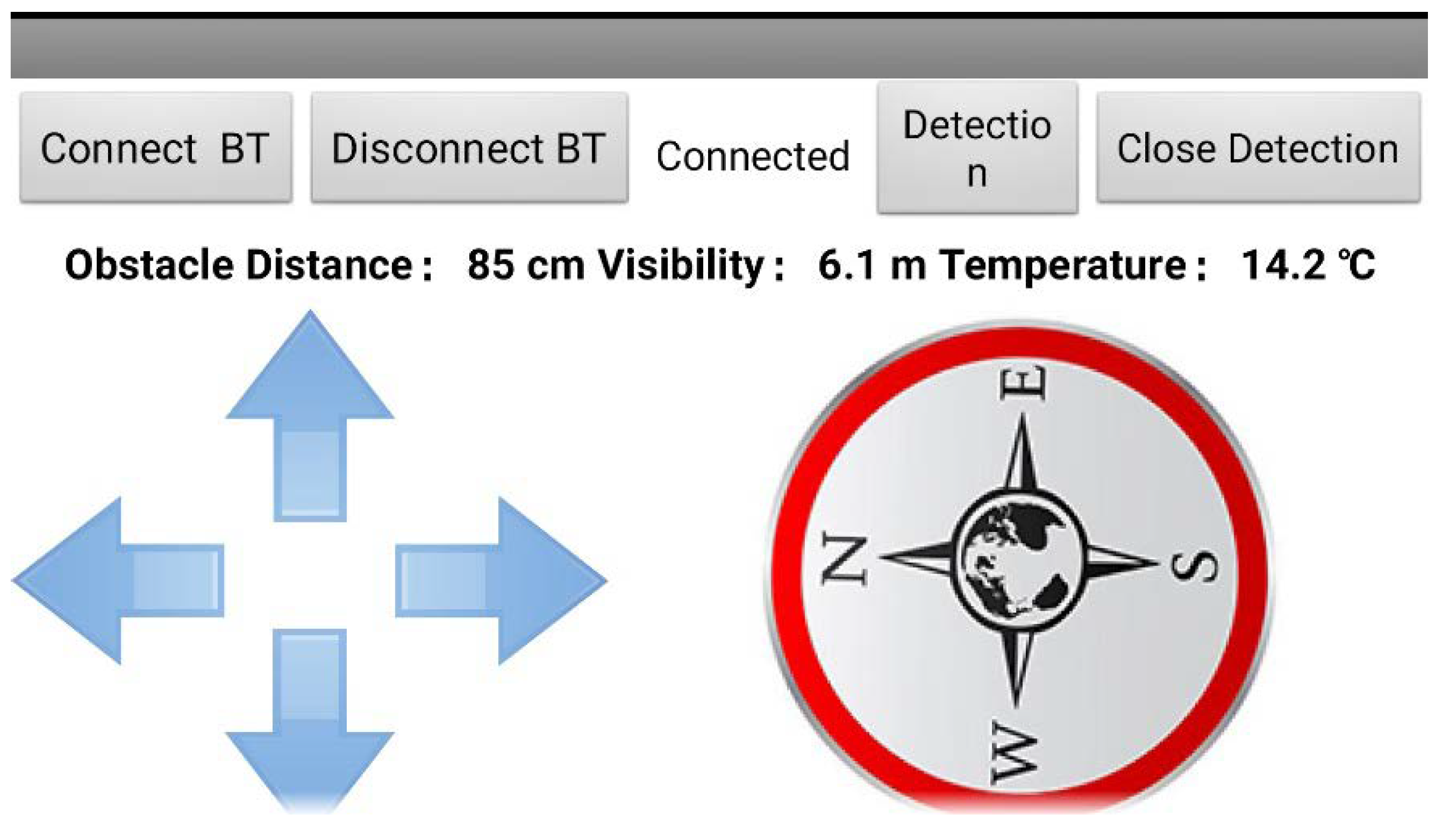
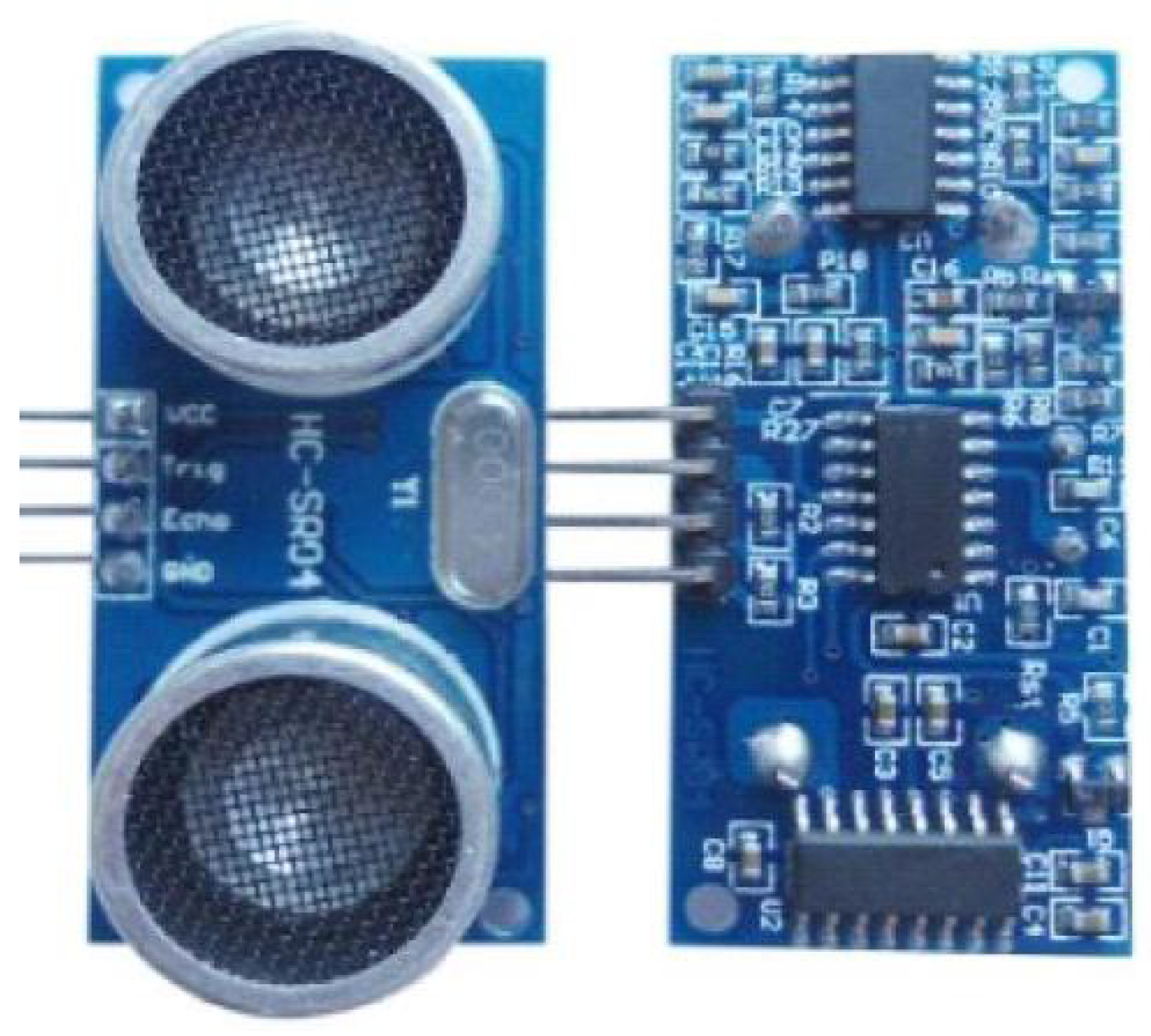
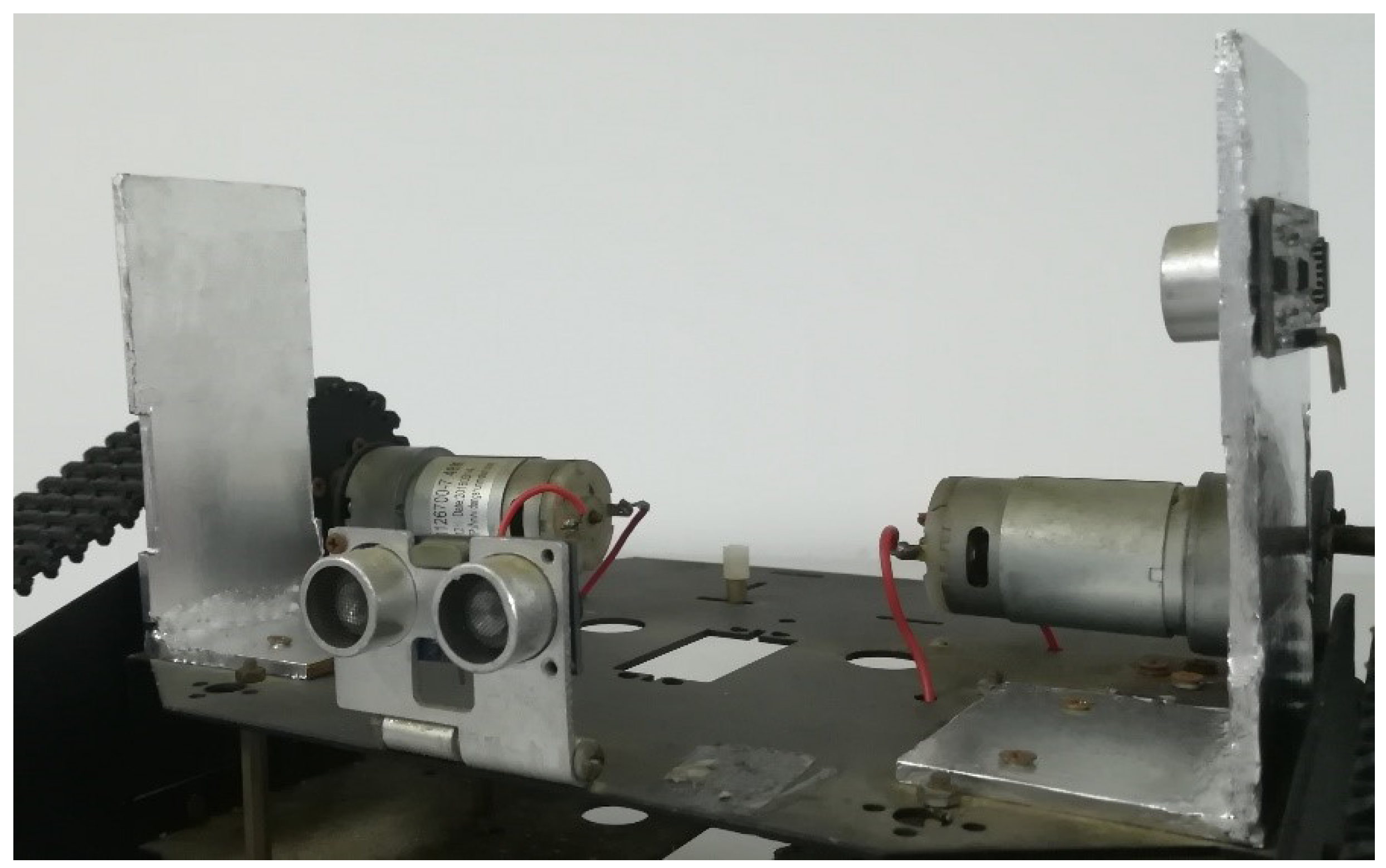
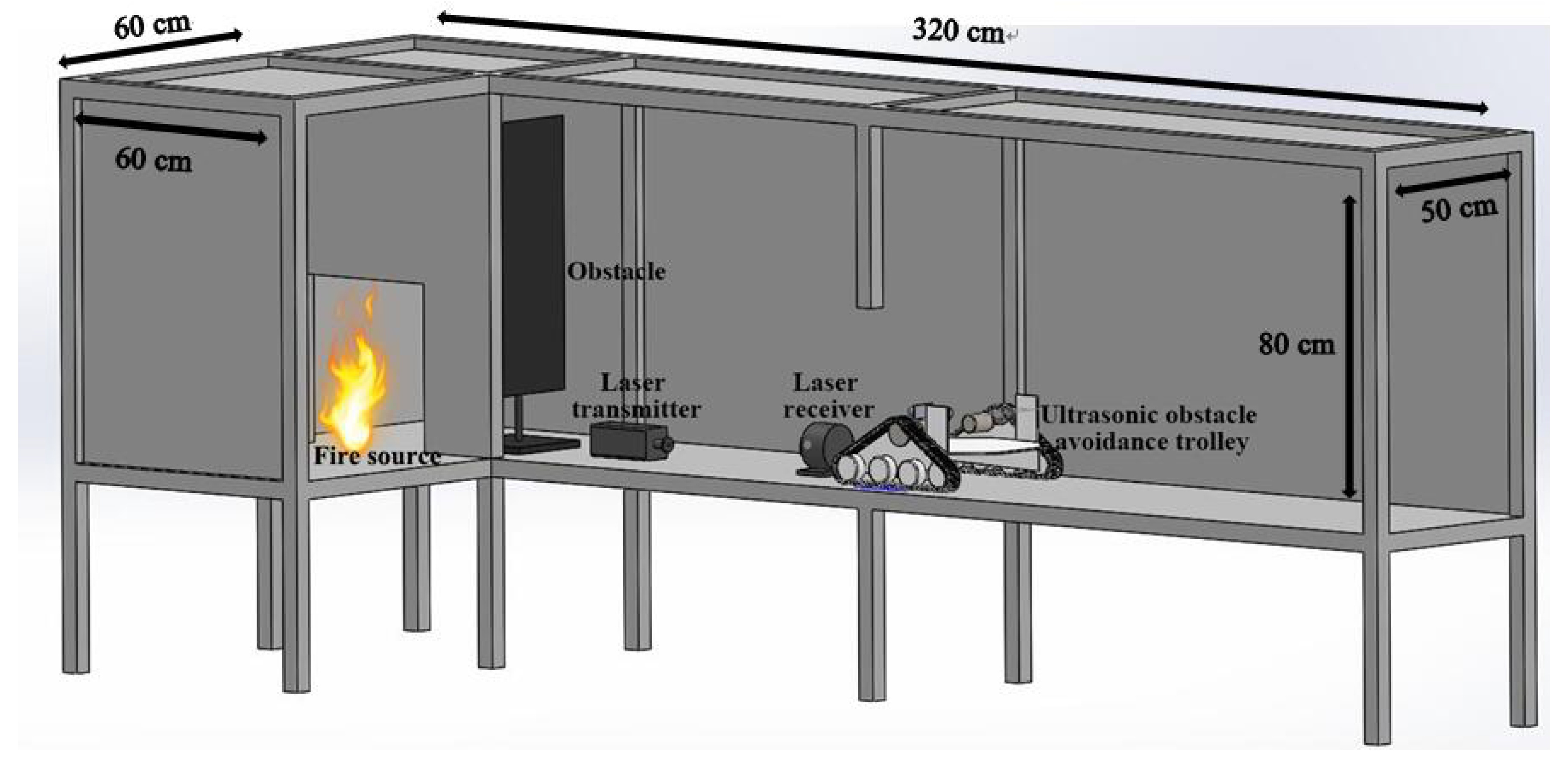

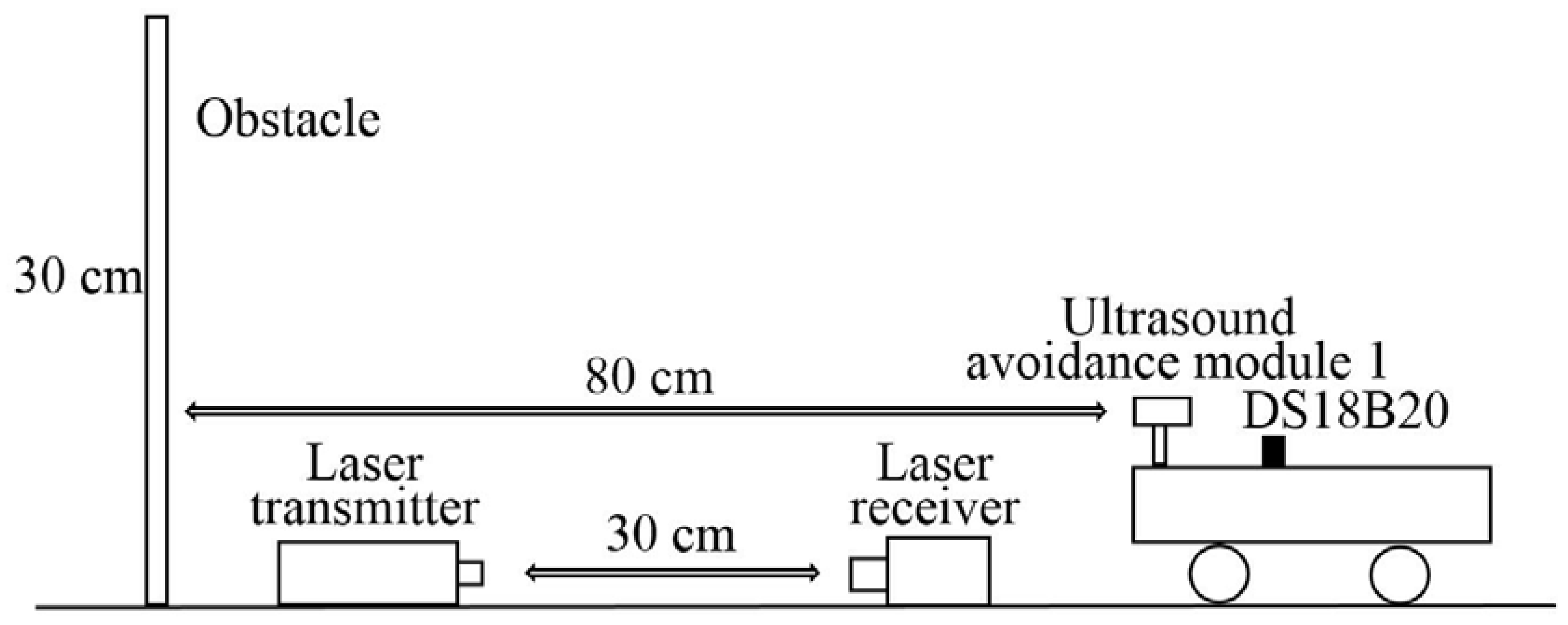
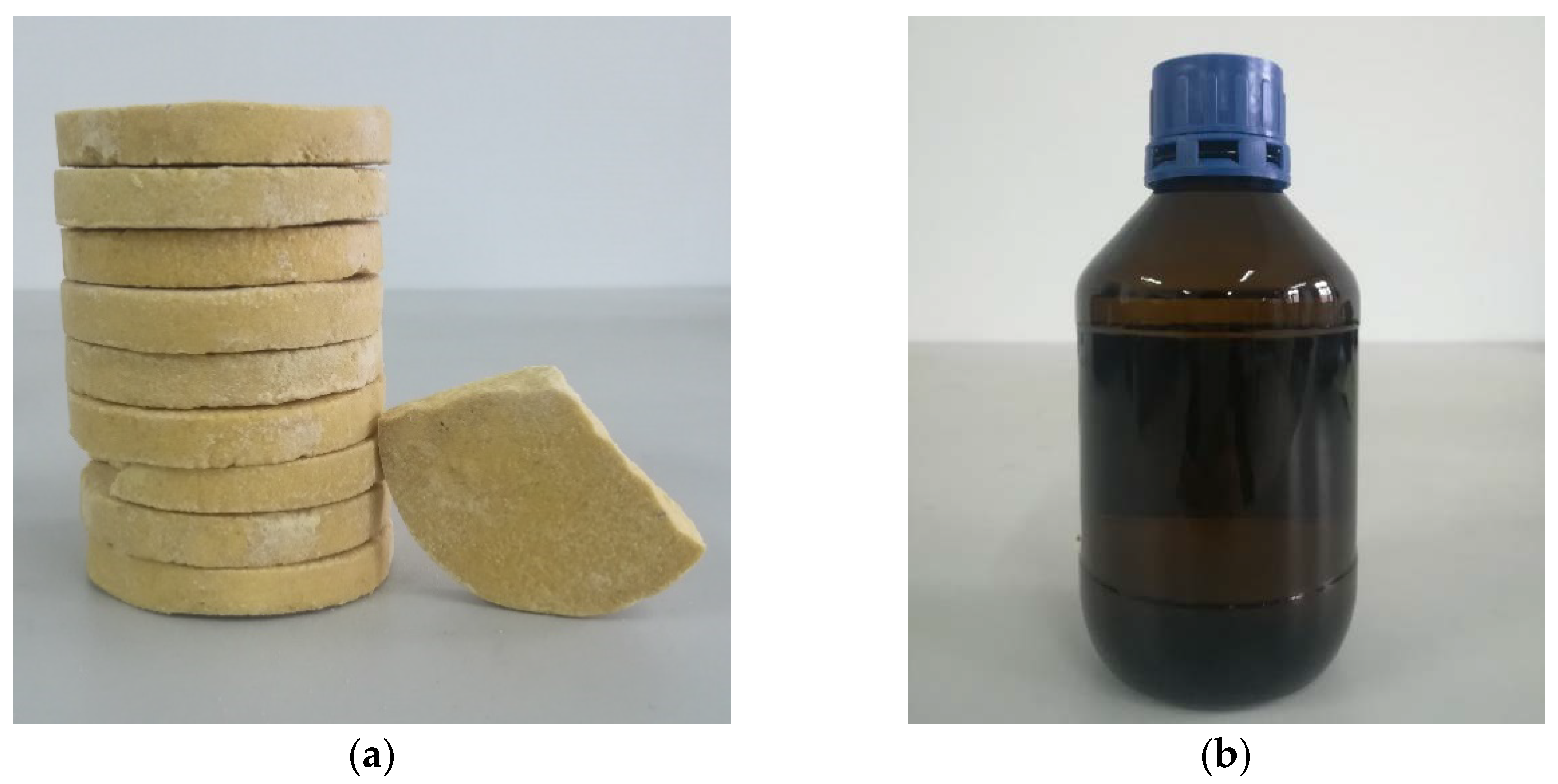
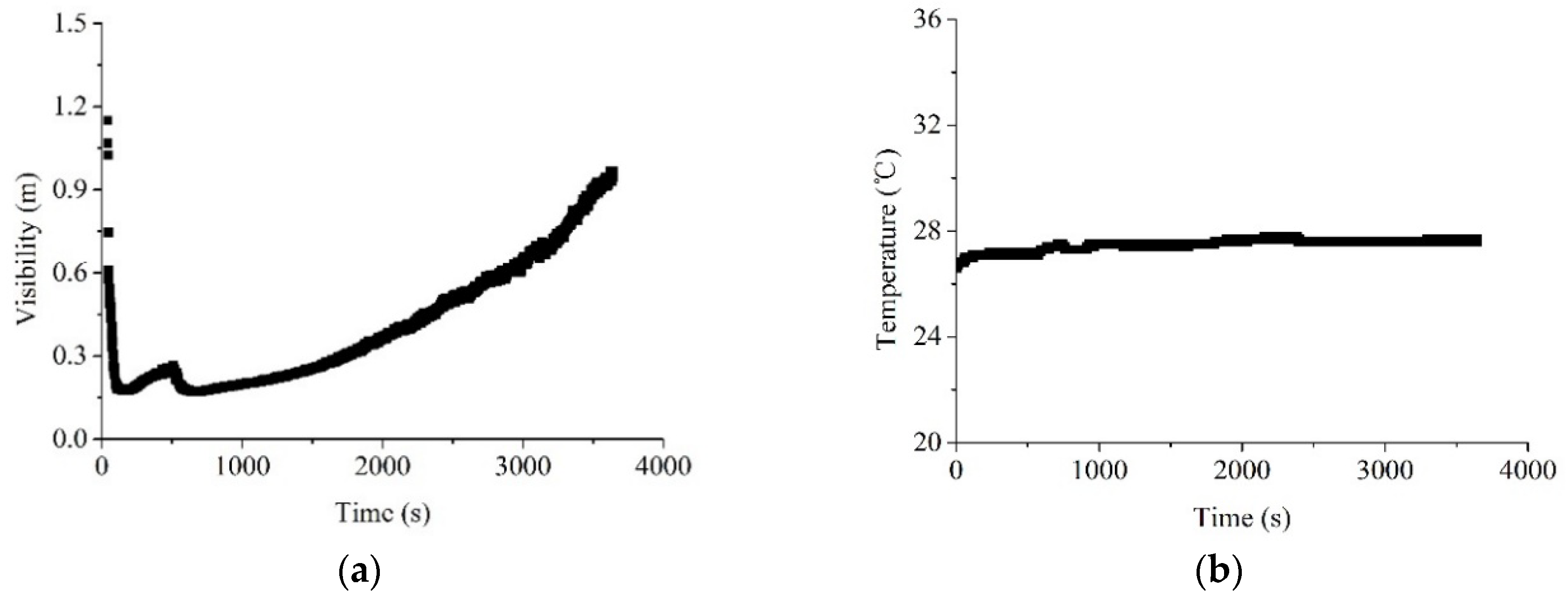
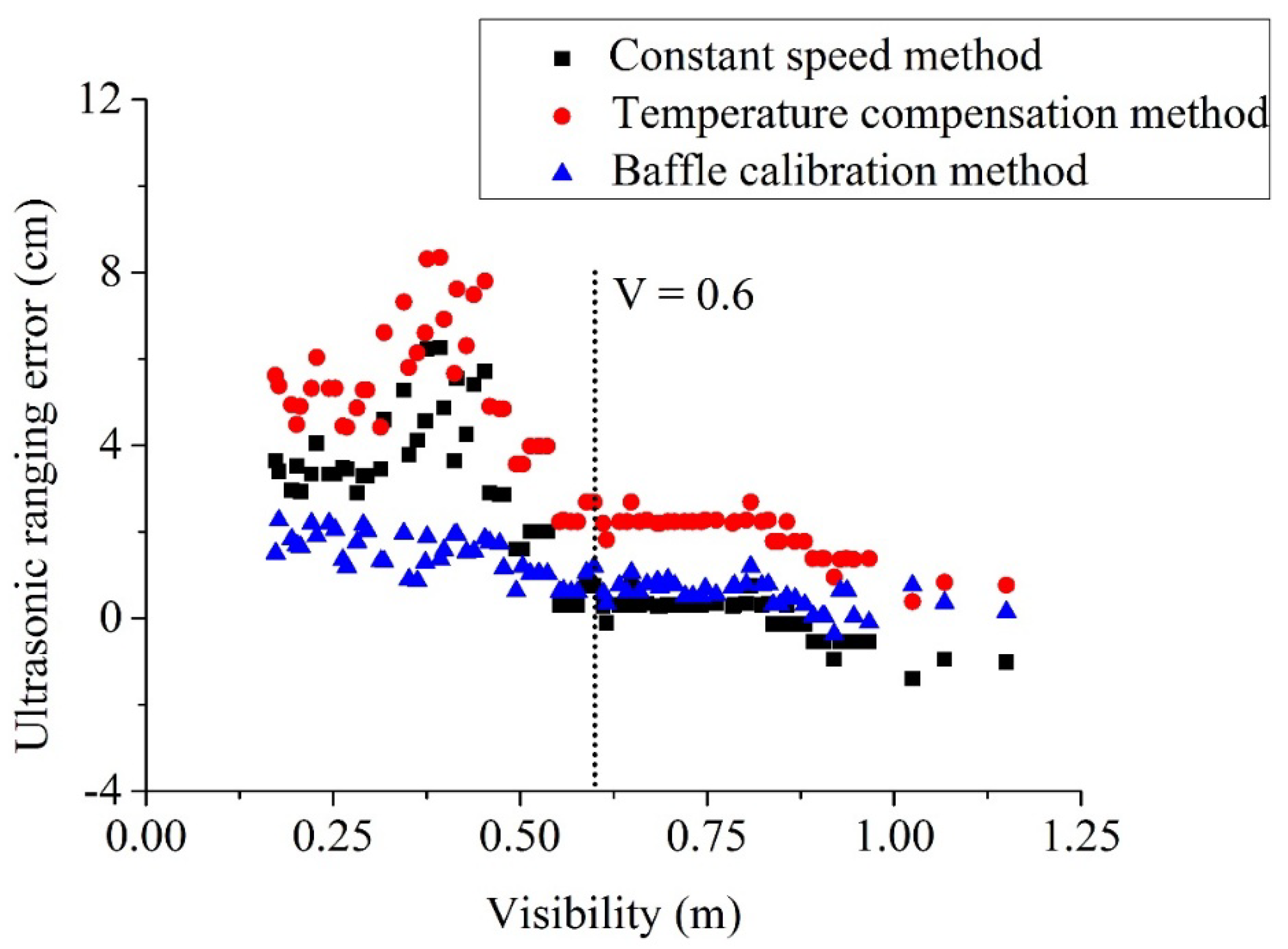
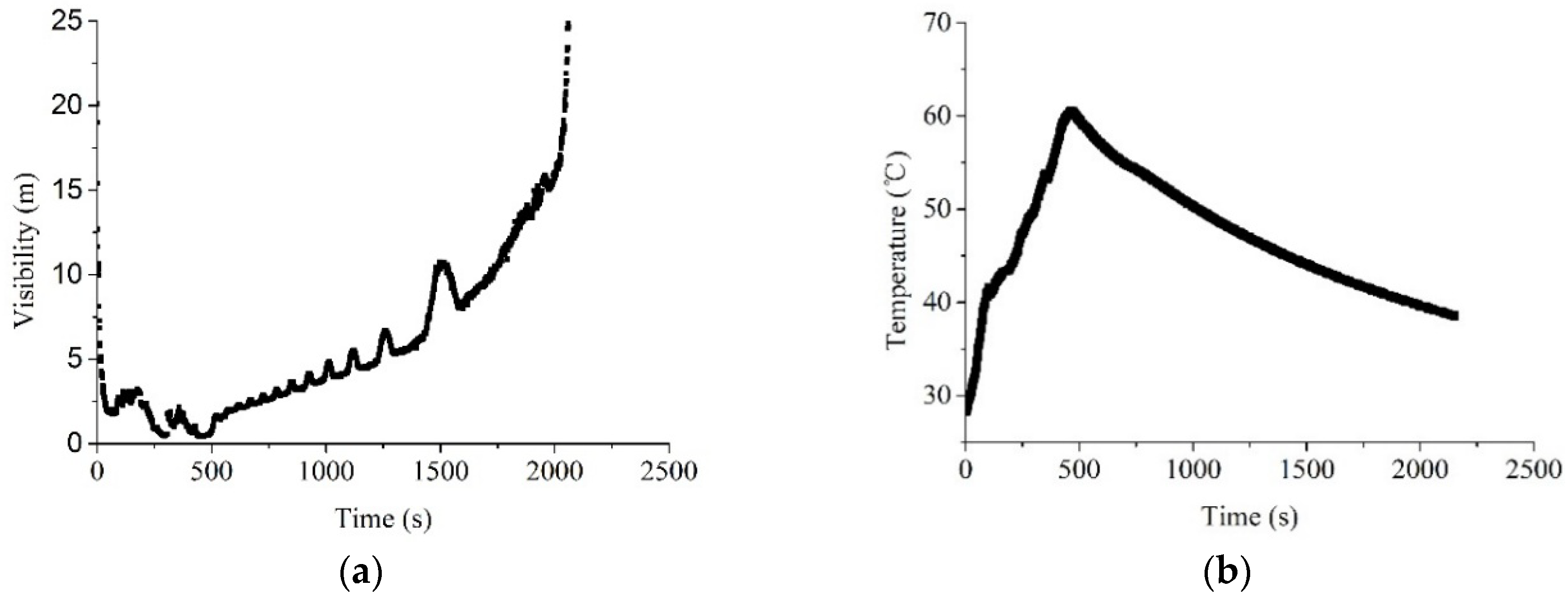
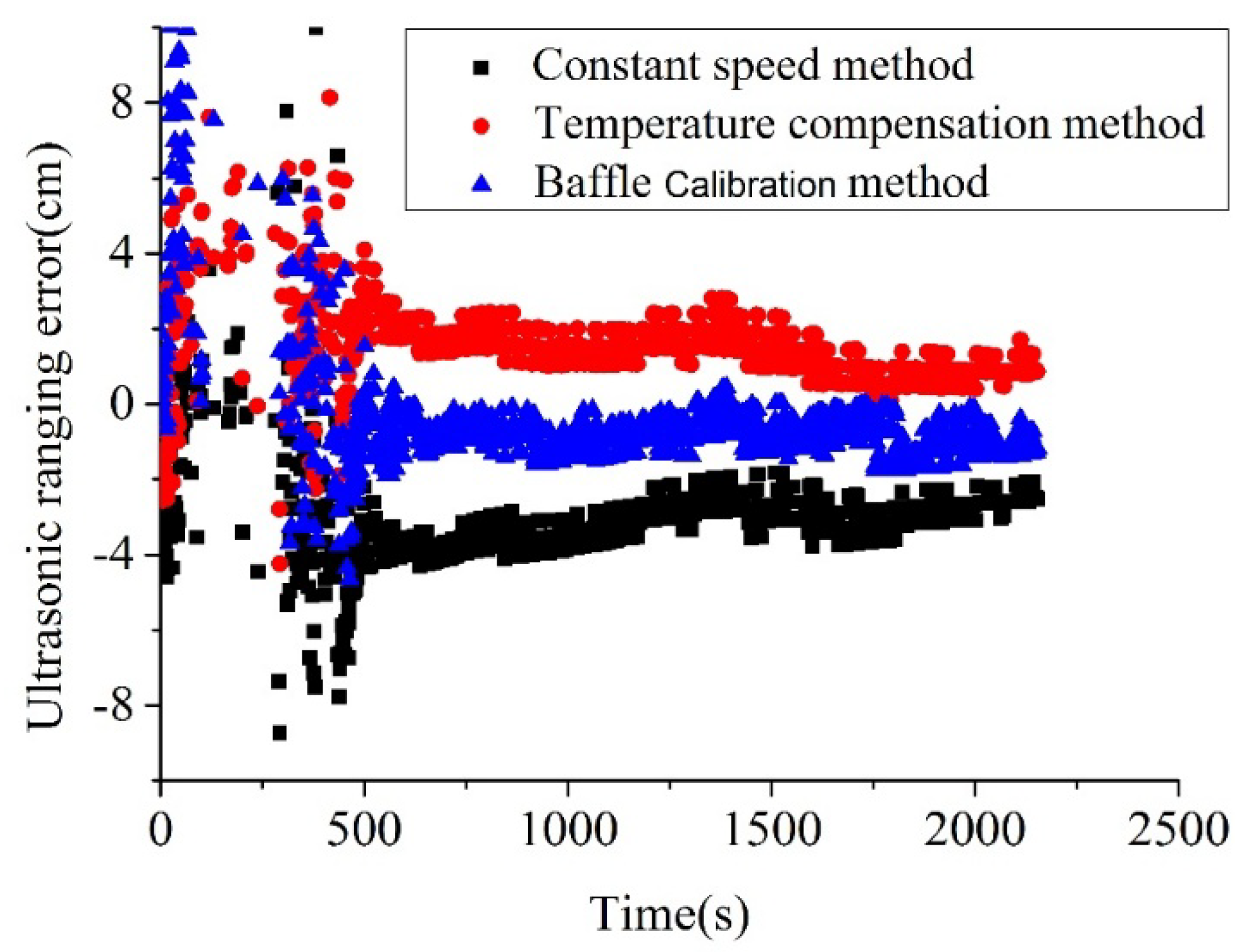
| Detection Device | Operating Wavelength | Applicability |
|---|---|---|
| Regular camera | ~0.4–0.7 μm | Error when visibility < 8 m; and Failure when visibility < 1 m |
| Infrared night vision device | ~0.4–0.8 μm | Failure when visibility < 4 m |
| Thermal infrared camera | 8–14 μm | Limited influence |
| Xbox KinectTM Depth Sensor | ~0.830 μm | Error when visibility < 8 m |
| Light Detection and Ranging (LIDAR) | 0.905 μm | Error when visibility < 4 m; Failure when visibility < 1 m |
| Ultrasound | ~6.8 mm (50 kHz) | Limited influence after calibration |
| Radar | ~11.5 mm (26 GHz) | Limited influence |
| Operating Voltage | Operating Current | Operating Frequency | Measurement Angle |
| DC 5V | 15 mA | 40 kHz | 15° |
| Maximum Distance | Minimum Distance | Input Trigger Signal | Output Response Signal |
| 400 cm | 2 cm | 10 μs transistor-transistor logic (TTL) pulse | TTL level signal |
| Method | Maximum Error (cm) | Minimum Error (cm) | Mean Absolute Deviation (cm) | Standard Deviation (cm) | Maximum Relative Errors |
|---|---|---|---|---|---|
| Constant speed | 6.25 | 0.1 | 1.9 | 1.8 | 7.81% |
| Temperature compensation | 8.3 | 0.3 | 3.6 | 2.0 | 10.4% |
| Baffle calibration | 2.2 | 0.04 | 1.0 | 0.6 | 2.75% |
| Method | Maximum Error (cm) | Minimum Error (cm) | Mean Absolute Deviation (cm) | Standard Deviation (cm) | Maximum Relative Errors |
|---|---|---|---|---|---|
| Constant speed | 6.7 | 1.6 | 3.2 | 0.69 | 8.4% |
| Temperature compensation | 4.1 | 0.8 | 1.6 | 0.61 | 5.12% |
| Baffle calibration | 2.1 | 0.02 | 0.9 | 0.44 | 2.62% |
© 2018 by the authors. Licensee MDPI, Basel, Switzerland. This article is an open access article distributed under the terms and conditions of the Creative Commons Attribution (CC BY) license (http://creativecommons.org/licenses/by/4.0/).
Share and Cite
Li, S.; Feng, C.; Liang, X.; Qin, H.; Li, H.; Shi, L. A Guided Vehicle under Fire Conditions Based on a Modified Ultrasonic Obstacle Avoidance Technology. Sensors 2018, 18, 4366. https://doi.org/10.3390/s18124366
Li S, Feng C, Liang X, Qin H, Li H, Shi L. A Guided Vehicle under Fire Conditions Based on a Modified Ultrasonic Obstacle Avoidance Technology. Sensors. 2018; 18(12):4366. https://doi.org/10.3390/s18124366
Chicago/Turabian StyleLi, Sen, Chunyong Feng, Xiaoge Liang, Hengjie Qin, Haihang Li, and Long Shi. 2018. "A Guided Vehicle under Fire Conditions Based on a Modified Ultrasonic Obstacle Avoidance Technology" Sensors 18, no. 12: 4366. https://doi.org/10.3390/s18124366
APA StyleLi, S., Feng, C., Liang, X., Qin, H., Li, H., & Shi, L. (2018). A Guided Vehicle under Fire Conditions Based on a Modified Ultrasonic Obstacle Avoidance Technology. Sensors, 18(12), 4366. https://doi.org/10.3390/s18124366




